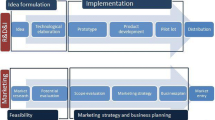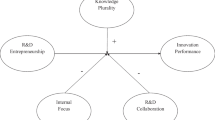Abstract
In this paper we focus on the performance impact associated with whether R&D or marketing takes the lead in product innovations and/or product development. We examine empirically the performance of a sample of entrepreneurial firms across 10 European Union countries for which we can identify alternative regimes in which R&D, or in which marketing, is viewed as being relatively more important in creating and sustaining the firm’s competitive advantage. We find that when R&D is the dominant strategy, firms realize greater growth in sales, other factors held constant.
Similar content being viewed by others
Notes
Surprisingly, much of the R&D/marketing interface literature has ignored the early work of Mansfield. Mansfield and Wagner (1975, p. 184) noted that one might expect the probability of technical completion of an R&D project, the probability of commercialization of the resulting technology, and the economic success of the innovation in the market to be influenced by “the extent to which the firm’s R&D portfolio is based on ideas coming from the R&D department, as distinct from the marketing department and other parts of the firm.”
Malerba (2010, p. 4) defines KIE as follows: “Knowledge-intensive entrepreneurship concerns new ventures that introduce innovations in the economic systems and that intensively use knowledge. From this broad definition, it follows that knowledge-intensive entrepreneurship may take place in various ways: through the foundation of new firms or through the display of entrepreneurial spirit with existing firms or through the action of single individuals within non-profit organizations such as universities or public laboratories.”
In Greek mythology the word Aegis refers to the powerful shield carried by Athena and Zeus.
The high-tech industrial sector is defined in the AEGIS database to include aerospace; computers and office machinery; radio-television communication equipment; manufacture of medical, precision and optional instruments; pharmaceuticals; manufacturer of electrical machinery and apparatus, manufacturer of machinery and equipment, chemical industry.
Two part-time employees are assumed to equal one full-time employee.
Note that Emp is not correlated with either RDDmy or RDGap. This lack of correlation between firm size and the R&D/marketing interface complements the earlier findings of Link and Zmud (1986) described in footnote 2.
Country fixed effects are controlled for in each specification in Table 4.
The regression results that include Emp 2 are available on request from the authors.
References
Amoroso, S., Moncada-Paternò-Castello, P., & Vezzani, A. (2016). R&D profitability: the role of risk and knightian uncertainty. Small Business Economics. doi:10.1007/s11187-016-9776-z. forthcoming.
Audretsch, D. B., Kuratko, D. F., & Link, A. N. (2016). Dynamic entrepreneurship and technology-based innovation. Journal of Evolutionary Economics, 26, 603–620.
Auh, S., & Merlo, O. (2012). The power of marketing within the firm: its contribution to business performance and the effect of power symmetry. Industrial Marketing Management, 41, 861–873.
Caloghirou, Y., Protogerou, A., & Tsakanikas, A. (2011). Advancing knowledge-intensive entrepreneurship and innovation: final report summarizing survey methods and results for economic growth and social well-being in Europe. http://cordis.europa.eu/publication/rcn/16140_en.html. Accessed 22 July 2016.
Cunningham, J. A., & Link, A. N. (2016). Exploring the effectiveness of research and innovation policies among European Union countries. International Entrepreneurship and Management Journal, 12, 415–425.
Gupta, A. K., Raj, S. P., & Wilemon, D. (1985). The R&D-marketing interface in high-technology firms. Journal of Product Innovation Management, 2, 12–24.
Gupta, A. K., Raj, S. P., & Wilemon, D. (1986). A model for studying R&D-marketing interface in the product innovation process. Journal of Marketing, 50, 7–17.
Homburg, C., & Pflesser, C. (2000). A multi-layer model of market-oriented organizational culture: measurement issues and performance outcomes. Journal of Marketing Research, 37, 449–462.
Link, A. N., & Swann, C. A. (2016). R&D as an investment in knowledge based capital. Journal of Industrial and Business Economics, 43, 11–24.
Link, A. N., & Zmud, R. W. (1986). Additional evidence on the R&D/marketing interface. IEEE Transactions on Engineering Management, EM-33, 43–44.
Malerba, F. (2010). Knowledge-intensive entrepreneurship and innovation systems: evidence from Europe. London: Routledge.
Mansfield, E., & Wagner, S. (1975). Organizational and strategic factors associated with probabilities of success in industrial R&D. The Journal of Business, 48, 179–198.
Moenaert, R. K., Souder, W. E., De Meyer, A., & Deschoolmeester, D. (1994). R&D-marketing integration mechanisms, communication flows, and innovation success. Journal of Product Innovation Management, 11, 31–45.
O’Cass, A., & Ngo, L. V. (2011). Winning through innovation and marketing: lessons from Australia and Vietnam. Industrial Marketing Management, 40, 1319–1329.
Pauwels, K., Silva-Risso, J., Srinivasan, S., & Hanssens, D. M. (2004). New products, sales promotions, and firm value: the case of the automobile industry. Journal of Marketing, 68, 142–156.
Song, X. M., & Dyer, B. (1995). Innovation strategy and the R&D marketing- interface in Japanese firms: a contingency perspective. IEEE Transactions on Engineering Management, 42, 360–371.
Souder, W. E. (1977). Effectiveness of nominal and interacting group decision processes for integrating R&D and marketing. Management Science, 23, 595–605.
Souder, W. E., & Chakrabarti, A. K. (1978). The R&D/marketing interface: results from an empirical study of innovation projects. IEEE Transactions on Engineering Management, EM-25, 88–93.
Srinivasan, S., Pauwels, K., Silva-Risso, J., & Hanssens, D. M. (2009). Product innovations, advertising, and stock returns. Journal of Marketing, 73, 24–43.
Stock, R. M., & Reiferscheid, I. (2014). Who should be in power to encourage product program innovativeness, R&D or marketing? Journal of the Academy of Marketing Science, 42, 264–276.
Szymanksi, D. M., Kroff, M. W., & Troy, L. C. (2007). Innovativeness and new product success: insights from the cumulative evidence. Journal of the Academy of Marketing Science, 35, 35–52.
Wang, Q., & Montaguti, E. (2002). The R&D-marketing interface and new product entry strategy. Marketing Intelligence & Planning, 20, 82–85.
Zhou, K. Z., Yim, C. K., & Tse, D. K. (2005). The effects of strategic orientations on technology- and market-based breakthrough innovations. Journal of Marketing, 69, 42–60.
Acknowledgements
The authors wish to thank the AEGIS consortium for providing data of the AEGIS survey which supported the empirical investigation of knowledge-intensive entrepreneurship in Europe in different sectoral, country and socioeconomic contexts. This survey was conducted in the context of the AEGIS research project (Advancing Knowledge-Intensive Entrepreneurship and Innovation for Economic Growth and Social Well-being in Europe) co-funded by the European Commission under Theme 8 “Socio-Economic Sciences and Humanities” of the 7th Framework Programme for Research and Technological Development.
Author information
Authors and Affiliations
Corresponding author
Rights and permissions
About this article
Cite this article
Boles, J., Link, A.N. On the R&D/marketing interface in knowledge intensive entrepreneurial firms. Int Entrep Manag J 13, 943–952 (2017). https://doi.org/10.1007/s11365-016-0429-0
Published:
Issue Date:
DOI: https://doi.org/10.1007/s11365-016-0429-0




